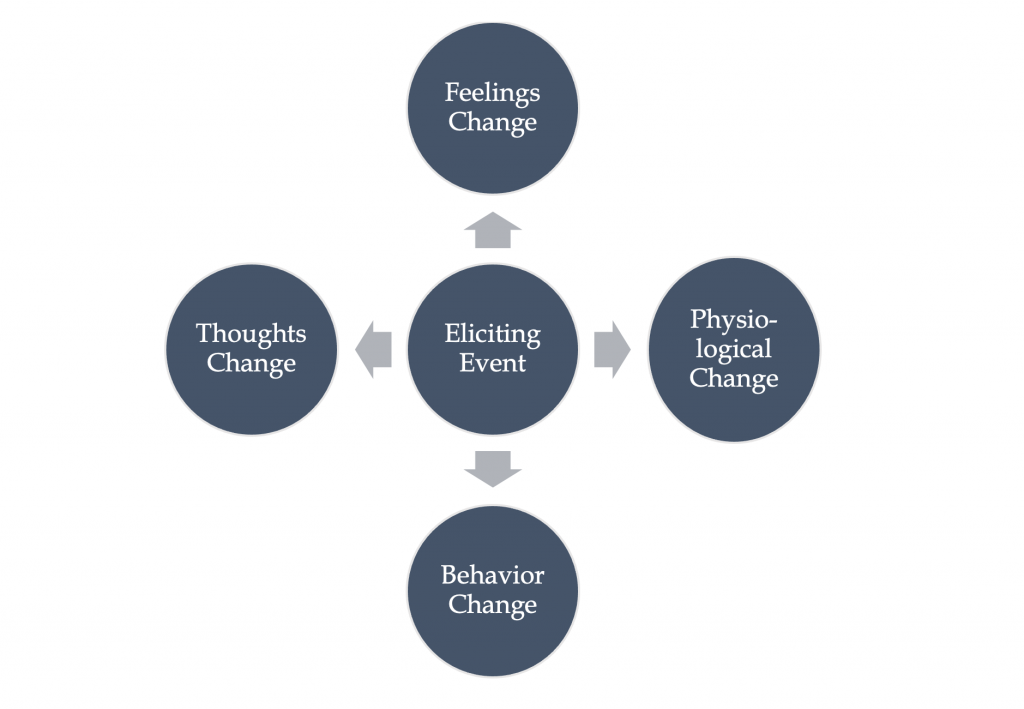Chapter 1: What is an Emotion?
Defining an Emotion
Is it an emotion?
Below are two interactive activities that require you to drag a “Yes” or a “No” into the drop boxes next to terms that may or may not be an emotion. If you think the term next to the drop box is an emotion, drag the “Yes” label into the box. If you do not think the term is an emotion, drag the “No” label into the corresponding drop box.
Below are two H5P activities that require the user to drag a yes or no label into the drop box corresponding with the term next to it to answer the question “Is this an emotion”? The drop boxes are labeled with the term in the name for easy identification. For example: the drop box for the term “feeling pleasant” is labeled “Feeling pleasant drop box”. “feeling pleasant” is the term the user is to assess as an emotion or not. drag the yes text box or the no text box into the “feeling pleasant” drop box to answer.
How is an emotion defined?
Keltner and Gross (1999, p. 468) define an emotion as an “episodic, relatively short-term, biologically-based patterns of perception, experience, physiology, action, and communication that occur in response to specific physical and social challenges and opportunities.” Let’s break this definition down.
An emotion is comprised of four components, as displayed in Figure 1. As identified by Keltner and Gross (1999), The four components are behaviors (“action” and “communication”), subjective feelings (“experience”), thoughts (“perception”), and physiology (“physiology”). These four components change after an eliciting event occurs. An eliciting event is the situational cause that activates changes in these four components. An eliciting event could be external to the self, such as when the presence of a bear in our environment would cause fear. The eliciting event could be internal to the self, such as when we experience a drop in self-esteem because we lied to our friend, thus causing the emotion guilt.
It is important to note that Keltner and Gross’ (1999) definition suggests that emotions are evolutionarily adaptive (“occur in response to physical and social challenges and opportunities”). This means that the emotion helps us to solve adaptive problems (the “challenges and opportunities”) and thus increases the survival of genes. For instance, the emotion disgust helps us to solve the adaptive problem of consuming poisonous food. Thus, disgust would be the adaptation that developed such that when we experience disgust we avoid the food that elicited the disgust. As we will discuss later, some researchers believe that emotions are adaptive, whereas others believe they are not adaptive.
Human emotion is a sub-field of social psychology. Social psychology is a field of psychology that focuses on situational causes of behaviors, thoughts, and feelings. Thus, from a social psychology perspective, the eliciting event is the situational influence that causes the emotion. When the situation or eliciting event changes, we experience these 4 subsequent changes, which comprise the emotion.
Figure 1
Representation of the relationship between the eliciting events and four emotions components

Behavior changes are defined as any change in observable behavior during the emotion episode. Behavior changes include facial expressions, approach/avoidance behavior, and changes in vocal tone. Subjective feelings are conscious, self-reported feelings. How are you feeling right now? Bored? Angry? Joyful? These are your subjective feelings. Physiological changes include any changes in sympathetic nervous system (SNS) activity, changes in parasympathetic nervous system (PNS) activity, changes in brain activity, and changes in hormone and neurotransmitter levels. For instance, when we experience fear, our heart rate increases, a change in our physiology. Finally, the term we used to describe our thoughts about the eliciting event and our thoughts about our emotional experiences is cognitive appraisals. Cognitive appraisals represent any change in thoughts, perceptions, and interpretations. Specifically, cognitive appraisals may include interpretation of the eliciting event (i.e. what caused the emotion?), and interpretations of other component changes (why is our heart beating? Why are we running away?). Later in the course, we will discuss a variety of cognitive appraisal dimensions. Some of these are:
- Do we feel unpleasant or pleasant?
- Is the eliciting event expected or novel and unexpected?
- Do we perceive that someone violated a moral?
- Do we perceive whether our self-esteem dropped? or increased?
Emotions researchers generally agree that an emotion comprises these four component changes and that these components change after an eliciting event occurs. Although, some disagree over whether two components are required – behavior changes and cognitive appraisals (those highlighted circles in Figure 1 above). Often, emotion researchers focus their research area on a specific component area. For example, some researchers focus on cognitive appraisals, whereas others may focus on physiological changes.
Re-Try ‘Is it an emotion?’ Activity
Below are two interactive activities that require you to drag a “Yes” or a “No” into the drop boxes next to terms that may or may not be an emotion. If you think the term next to the drop box is an emotion, drag the “Yes” label into the box. If you do not think the term is an emotion, drag the “No” label into the corresponding drop box. You can look at your previous answers by clicking here
Below are two H5P activities that require the user to drag a yes or no label into the drop box corresponding with the term next to it to answer the question “Is this an emotion”? The drop boxes are labeled with the term in the name for easy identification. For example: the drop box for the term “feeling pleasant” is labeled “Feeling pleasant drop box”. “feeling pleasant” is the term the user is to assess as an emotion or not. drag the yes text box or the no text box into the “feeling pleasant” drop box to answer.

